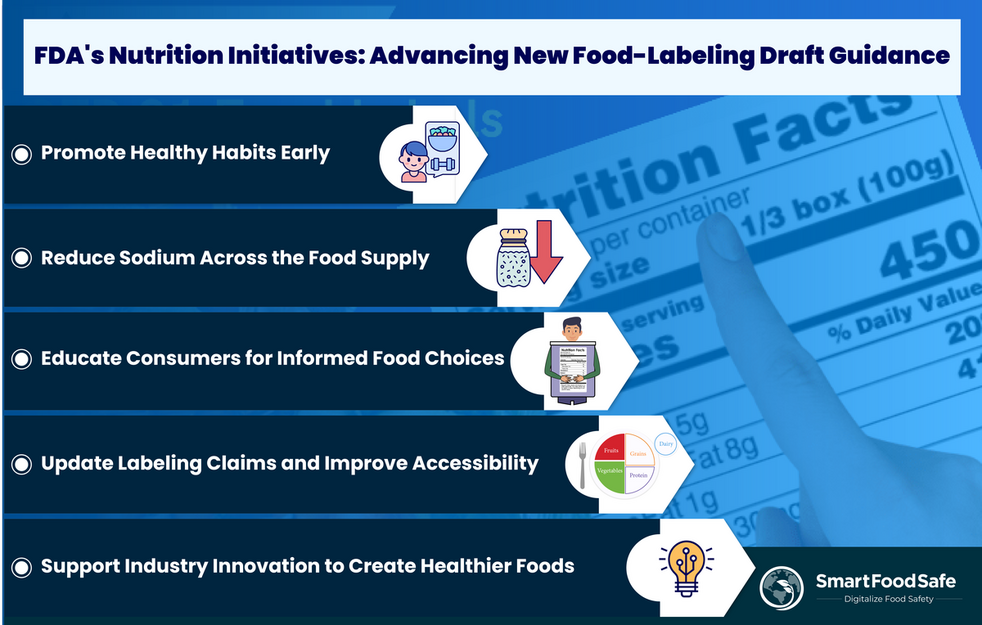
The U.S. Food and Drug Administration (FDA) Commissioner Robert M. Califf, M.D. revealed in an FDA News Release that diet-related chronic diseases are the leading causes of death and disability in the U.S.
The majority of the people in the U.S. tend not to consume sufficient amounts of fruits, vegetables, dairy, or whole grains, while their intake of saturated fat, sodium, and added sugars remains excessive, depicting that the eating patterns in the U.S. do not align with the updated federal dietary guidelines. The FDA recognized that it could play a vital role in helping consumers make informed choices about the foods they eat and improve the health of millions of Americans. Hence, came forth the latest Food Labeling Draft Guidance.
FDA released the latest food-labeling draft guidance on March 24th, 2023, outlining their up-to-date recommendations for utilizing Dietary Guidance Statements in food labeling. The objective is to ensure that these statements effectively encourage and support healthy eating habits while assisting food enterprises in their implementation.
Dietary guidance statements comprise written or visual content derived from authoritative consensus reports provided by health organizations, nutrition experts, or government bodies. Labeling statements like Dietary Guidance Statements on food packages assist consumers in making healthier choices by providing quick and decisive nutrition information. Some key elements that are seen in dietary guidance statements are macronutrient balance, fruit and vegetable consumption, whole grains, lean protein sources, healthy fats, added sugars and sodium, portion control, personalized approach, and sustainable food choices.
FDA’s Nutrition Initiatives: Paving the Way for the New Draft Guidance on Food Labeling
At the FDA Conference on Hunger, Nutrition, and Health on September 28, 2022, the White House published a National Strategy to end hunger and increase healthy eating and physical activity by 2030. As part of the strategy, the FDA has implemented multiple initiatives to accelerate efforts in empowering consumers with information and fostering a healthier food supply.
The FDA’s Nutrition Initiatives aim to enhance access to healthier foods and provide easily accessible nutrition information to help individuals in the United States identify healthier choices, thus improving everyone’s health and wellness. A primary aspect of their work concentrates on claims and nutrition-related statements on food labeling, as they can be a powerful tool for change. They can act as conclusive signals to help consumers, particularly those with lower nutrition literacy, understand nutrition information and make healthier picks.
The FDA seeks input from various stakeholders through public meetings and comments to develop these guidance statements. They consider consensus reports, such as the Dietary Guidelines for Americans, 2020-2025 (Dietary Guidelines), as the basis for labeling comments representing or suggesting how a food or food group contributes to a nourishing diet system. The Dietary Guidelines, published every five years by the U.S. Department of Health and Human Services (HHS) and the U.S. Department of Agriculture (USDA), are devised with the input of science-based recommendations of a panel of experts called the Dietary Guidelines Advisory Committee.
Traditionally, labeling claims have revolved around specific nutrients and their relationship to diseases. However, as scientific knowledge in nutrition has advanced, recommendations have shifted towards considering the overall dietary pattern and how foods work together to affect health.
The FDA Dietary Guidance Statements provide manufacturers with an additional set of comments that can be used on-pack, beyond nutrient content claims or “healthy” claims, which will be instrumental in advocating better, and nutrition-conscious purchase decisions. The main highlights of the draft guidance are given below:
Definition of Dietary Guidance Statements
The Dietary Guidance Statements are defined in the draft guidance as words or vignettes that represent how the consumption of a certain food contributes to an overall healthy diet. They may also include the use of USDA’s “MyPlate” symbol on food packaging.
Validity for the Source of Dietary Guidance Statements
The draft guidance defines a "consensus report" as the result of qualified experts studying an issue with minimized biases. This ensures objective and evidence-based nutrition information. Reports undergo rigorous scientific review, and food manufacturers should incorporate key recommendations into their Dietary Guidance Statements, representing critical findings.
“Food Group Equivalents” Concept
For a food item to be labeled with Dietary Guidance Statement, it must contain a “meaningful amount” of the mentioned food or food groups, quantified by the FDA’s “food group equivalents” standard. The FDA’s “food group equivalents” standard is a proposed framework to redefine the concept of “healthy” food products. The standard focuses on ensuring that nutrient-dense foods that help consumers build a diet consistent with current dietary recommendations qualify for the “healthy” claim.
Recommendations for Nutrient Levels for a Product with Dietary Guidance Statements
The draft guidance emphasizes that food products carrying a Dietary Guidance Statement should adhere to specific limits regarding certain nutrients. These limits pertain to saturated fat, sodium, and added sugars and are designed to ensure that these nutrients are not present in excessive amounts. The recommended nutrient levels differ based on the food item category, with main dishes and meals having more flexibility compared to other products.
Applicability of Dietary Guidance Statements
The draft guidance focuses on individuals aged two and older in its Dietary Guidance Statements, excluding infants and children under two. Food quantity and nutrient limit recommendations vary significantly for these age groups, as outlined in consensus reports. The FDA will carefully assess the use of Dietary Guidance Statements for the youngest population groups.
Food manufacturers often face the tedious task of navigating and maintaining compliance with complex labeling requirements for consumer safety and informed decisions. Smart Food Safe offers modules—Smart Specification, Smart Compliance, and Smart Label—to simplify compliance. Smart Specification manages material specifications digitally, covering ingredients, allergens, nutrition, packaging, recipes, and processes. Smart Label facilitates compliant food label creation and updates based on specifications. Smart Compliance ensures real-time compliance, automated release, regulatory documentation, supplier monitoring, and brand protection.
_1.png)